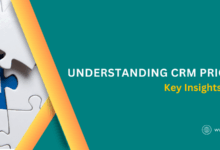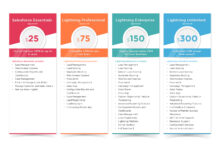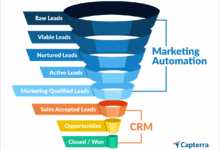CRM Software Cost: Everything You Need To Know
CRM software cost is a crucial aspect of any business operation, impacting budget decisions and overall efficiency. Let’s delve into the key factors, pricing models, hidden costs, and strategies to manage expenses effectively.
Factors influencing CRM software cost
When considering the cost of CRM software, there are several factors that can influence the overall price. Customization, user licenses, and integration requirements play a significant role in determining how much you will need to invest in a CRM system.
Customization
Customization is a key factor in determining the cost of CRM software. The more tailored the software needs to be to fit your specific business processes and requirements, the higher the cost is likely to be. Customization involves configuring the software to meet your unique needs, adding new features, or integrating with other systems. This customization process requires time and resources, which can impact the overall cost of the CRM software.
User Licenses
User licenses also play a crucial role in determining CRM software cost. The number of users who will be accessing the CRM system directly affects the pricing structure. Most CRM software providers offer tiered pricing based on the number of user licenses needed. As the number of users increases, so does the cost of acquiring licenses for each user. It is essential to accurately estimate the number of users who will require access to the CRM system to avoid unnecessary expenses.
Integration Requirements
Integration requirements can also impact the cost of CRM software. If your business relies on other software systems or tools that need to be integrated with the CRM software, this can add to the overall cost. Integration involves connecting different systems to ensure seamless data flow and communication between them. The complexity of the integration process, the number of systems to be integrated, and the level of customization required can all contribute to higher costs.
Types of CRM software pricing models
When it comes to CRM software pricing, there are several models that companies can choose from based on their specific needs and budget. Understanding the different pricing structures can help businesses make informed decisions about which option aligns best with their requirements.
One-time Payment vs. Subscription-based Pricing Models
One-time payment and subscription-based pricing models are two common approaches for CRM software pricing. Here is a comparison of the two:
- One-time Payment: This model involves paying a lump sum upfront for perpetual access to the CRM software. While it may require a significant initial investment, it eliminates recurring costs and provides long-term ownership of the software.
- Subscription-based: With this model, users pay a recurring fee at regular intervals (monthly, quarterly, or annually) to access the CRM software. This option offers flexibility in terms of scalability and upgrades, but can result in higher costs over time compared to a one-time payment.
Benefits and Drawbacks of Pay-per-User Pricing
Pay-per-user pricing is another common model used by CRM software providers. Here are the advantages and disadvantages:
- Benefits:
- Allows companies to pay based on the number of users accessing the software, making it cost-effective for smaller teams or businesses with fluctuating user counts.
- Encourages efficient use of resources, as companies only pay for the users who actively utilize the CRM system.
- Drawbacks:
- Costs can add up quickly as the number of users increases, potentially making it less economical for larger organizations with a high user count.
- May lead to budget unpredictability, especially if user numbers fluctuate frequently, causing variability in monthly expenses.
Variations in Pricing Structures based on Features and Functionalities
CRM software providers often offer different pricing tiers based on the features and functionalities included in each package. Here are some common variations in pricing structures:
- Basic Tier: Entry-level package with essential CRM features, suitable for small businesses or startups with limited requirements.
- Advanced Tier: Mid-range package offering additional functionalities such as automation, customization, and integration options, catering to growing businesses with more complex needs.
- Enterprise Tier: Premium package with advanced features like analytics, AI capabilities, and dedicated support, designed for large corporations or enterprises with extensive CRM demands.
Hidden costs associated with CRM software
When considering the cost of implementing CRM software, it’s important to take into account the potential hidden costs that may arise throughout the process. These hidden expenses can significantly impact the overall budget and should not be overlooked.
Training and Support Expenses
One of the hidden costs associated with CRM software implementation is training and support expenses. While the software itself may come with a price tag, the training of employees to use the system effectively and ongoing support from the vendor can add up over time.
- Training sessions for employees to learn how to navigate the CRM system
- Cost of hiring external trainers or consultants for specialized training
- Ongoing support fees from the CRM software vendor for troubleshooting and maintenance
Data Migration and Storage Costs
Another hidden cost to consider is data migration and storage expenses. Moving existing data from legacy systems to the new CRM software can be a complex and costly process. Additionally, storing large amounts of data on the CRM platform may incur additional fees based on storage capacity.
- Cost of hiring data migration specialists to ensure a smooth transition
- Potential fees for additional storage space on the CRM software platform
- Data cleansing and de-duplication costs to maintain data accuracy
Scalability and Upgrades Expenses
Scalability and upgrades of the CRM software can also lead to additional expenses that are often overlooked initially. As your business grows and evolves, you may need to invest in upgrades to accommodate new features or increased user capacity.
- Cost of upgrading to a higher-tiered plan for more advanced features
- Fees for adding more user licenses as your team expands
- Customization costs for tailoring the CRM software to meet changing business needs
Cost-saving strategies for CRM software implementation
Implementing CRM software can be a significant investment for any business. To help minimize costs and maximize the return on investment, consider the following cost-saving strategies:
Negotiating prices with CRM software vendors
When discussing pricing with CRM software vendors, keep these tips in mind:
- Do your research to understand the market rates for CRM software and services.
- Consider asking for volume discounts if you are purchasing multiple licenses.
- Explore the possibility of bundling services or features to get a better deal.
- Don’t be afraid to negotiate and ask for a more favorable pricing structure.
Optimizing CRM software usage to minimize ongoing costs
To ensure you are getting the most out of your CRM software while keeping costs down, consider the following strategies:
- Provide thorough training to your employees to maximize system utilization.
- Regularly review and clean up data to avoid unnecessary storage costs.
- Automate processes and workflows to increase efficiency and reduce manual labor costs.
- Regularly monitor and analyze system usage to identify areas for improvement or cost savings.
Conducting a thorough ROI analysis before investing in CRM software
Before making a decision to invest in CRM software, it’s crucial to conduct a thorough ROI analysis. Consider the following factors:
- Calculate the potential cost savings and revenue growth that the CRM software can provide.
- Estimate the implementation and ongoing costs associated with the CRM software.
- Consider the intangible benefits such as improved customer satisfaction and loyalty.
- Compare the potential ROI of investing in CRM software with other business initiatives to prioritize investments effectively.
Customization options and their impact on CRM software cost
Customization plays a crucial role in tailoring CRM software to meet specific business needs. However, this level of personalization comes at a cost that organizations need to consider when implementing CRM solutions.
Costs associated with customizing CRM software
- Development Costs: Customizing CRM software involves coding and programming to modify the system according to the organization’s requirements. This requires skilled developers and incurs additional expenses.
- Consultation Fees: Organizations may need to seek advice from CRM experts or consultants to ensure that the customization aligns with their business goals. These consultation services come at a cost.
- Training and Support: Customized CRM software may require specialized training for employees to effectively use the system. Ongoing support and maintenance also contribute to the overall cost.
Impact of integrations with other tools and systems
- Integration with Third-party Apps: Integrating CRM software with other tools and systems, such as marketing automation platforms or accounting software, can enhance functionality but also increase customization costs due to the complexity of integration.
- Data Migration: Transferring data from existing systems to the customized CRM solution can be a time-consuming and costly process, especially if the data needs to be cleaned and mapped correctly.
Examples of industries where customization significantly impacts CRM software expenses
- Healthcare: Healthcare providers often require customized CRM solutions to manage patient records, appointments, and treatment plans effectively. The unique regulatory requirements and data security measures in the healthcare industry can escalate customization costs.
- Financial Services: Financial institutions need CRM software tailored to meet compliance regulations, track customer transactions, and manage financial portfolios. Customization to integrate with banking systems and ensure data security can lead to higher expenses.
Factors to consider when budgeting for CRM software
When budgeting for CRM software, there are several key factors to consider to ensure an accurate estimation of costs for the project. It is crucial to not only focus on the initial setup expenses but also take into account long-term costs to avoid any surprises down the line. By creating a comprehensive CRM software budget, businesses can effectively plan for the financial aspects of implementing and maintaining the software.
Importance of Long-term Costs
One of the most critical aspects of budgeting for CRM software is factoring in the long-term costs associated with the software. While the initial setup costs are important, it is equally essential to consider ongoing expenses such as subscription fees, maintenance costs, updates, and potential customization needs. By accounting for these long-term costs upfront, businesses can avoid financial strain and plan for sustainability.
Comprehensive CRM Software Budget Checklist
- Initial Setup Costs: Include expenses related to software purchase, installation, and configuration.
- Subscription Fees: Factor in recurring costs for accessing the CRM software.
- Maintenance and Support: Budget for ongoing maintenance, updates, and technical support services.
- Training and Implementation: Allocate funds for training sessions and implementation services to ensure successful adoption.
- Customization and Integration: Consider costs associated with customizing the software to fit specific business needs and integrating it with other systems.
- Data Migration: Estimate expenses for transferring existing data to the new CRM system.
- Consulting Services: Budget for consulting services if external expertise is required for implementation or optimization.
- Hardware Upgrades: If necessary, include costs for upgrading hardware to meet CRM software requirements.
Pricing transparency in the CRM software industry
In the CRM software industry, pricing transparency plays a crucial role in helping businesses make informed decisions when selecting a CRM software provider. Let’s delve into the level of transparency among CRM software vendors, the challenges faced by businesses, and best practices for evaluating pricing transparency.
Level of transparency among CRM software vendors
When it comes to pricing structures, CRM software vendors vary in their level of transparency. Some vendors provide detailed pricing information on their websites, including different pricing tiers, features included in each tier, and any additional costs. On the other hand, some vendors may require businesses to contact sales representatives for pricing information, which can lead to a lack of clarity and potential surprises in costs.
Challenges in understanding and comparing CRM software costs
Businesses often face challenges in understanding and comparing CRM software costs due to the complexity of pricing models, hidden costs, and varying feature sets. Without clear pricing information, businesses may struggle to accurately budget for CRM software implementation and may overlook important factors that could impact the total cost of ownership.
Best practices for evaluating pricing transparency
- Look for vendors that provide transparent pricing information upfront, including detailed breakdowns of costs and any potential additional fees.
- Compare pricing structures across different vendors to ensure you are getting the best value for your investment.
- Ask vendors about any hidden costs or fees that may not be clearly outlined in their pricing information.
- Consider the scalability of the pricing model and how costs may change as your business grows and requires additional features or users.
Case studies on successful CRM software cost management
In the realm of CRM software cost management, real-world examples of companies effectively controlling expenses can provide valuable insights for others looking to optimize their own CRM investments. Let’s delve into some case studies that showcase successful strategies in this area.
Case Study 1: Company A
Company A, a mid-sized retail business, implemented a CRM software solution to streamline customer interactions and boost sales. To manage costs effectively, they conducted a thorough analysis of their specific needs and opted for a cloud-based CRM system with scalable pricing. By customizing the software to align with their processes and training their employees efficiently, Company A achieved significant cost savings while enhancing customer relationships. The outcome was a 20% increase in sales revenue within the first year of CRM implementation.
Case Study 2: Company B
Company B, a tech startup, faced budget constraints when considering CRM software options. Instead of compromising on features, they negotiated with CRM vendors for a tailored pricing package that included essential functionalities at a reduced cost. By focusing on core requirements and avoiding unnecessary add-ons, Company B managed to stay within budget while still reaping the benefits of CRM software. As a result, they saw a 15% improvement in customer retention rates and a 25% reduction in customer acquisition costs.
Case Study 3: Company C
Company C, a multinational corporation, implemented a comprehensive CRM software suite across multiple departments to consolidate customer data and improve collaboration. To keep costs in check, they utilized open-source CRM solutions for certain divisions and integrated them seamlessly with the main CRM platform. This hybrid approach allowed Company C to optimize expenses without compromising on functionality. The outcome was a 30% increase in cross-selling opportunities and a 10% boost in customer satisfaction ratings.
Future trends in CRM software pricing
As technology continues to evolve at a rapid pace, the future of CRM software pricing is set to undergo significant changes. Advancements in artificial intelligence, automation, and data analytics are expected to impact how CRM software is priced and offered to businesses.
Shift towards Value-Based Pricing
One potential trend in CRM software pricing is a shift towards value-based pricing models. Instead of charging a flat fee for software licenses, vendors may start pricing their solutions based on the value they provide to each individual customer. This could result in more customized pricing structures that align closely with the specific needs and outcomes desired by businesses.
Subscription-Based Models Dominance
Subscription-based pricing models are likely to dominate the CRM software industry in the future. This allows businesses to pay a recurring fee for access to the software, ensuring they always have the latest updates and features. Such models also provide vendors with a steady revenue stream, incentivizing them to continuously improve their products.
Personalization and AI Pricing Algorithms
With the increasing emphasis on personalization and AI-driven insights in CRM software, pricing algorithms are expected to become more sophisticated. Vendors may leverage AI to analyze customer data, usage patterns, and business needs to offer personalized pricing plans. This level of customization could lead to more accurate pricing and better alignment between software costs and value delivered.
Ultimate Conclusion
In conclusion, understanding the intricacies of CRM software cost is essential for making informed choices that align with your business goals. By implementing cost-saving strategies and staying abreast of industry trends, you can optimize your CRM investment for long-term success.


